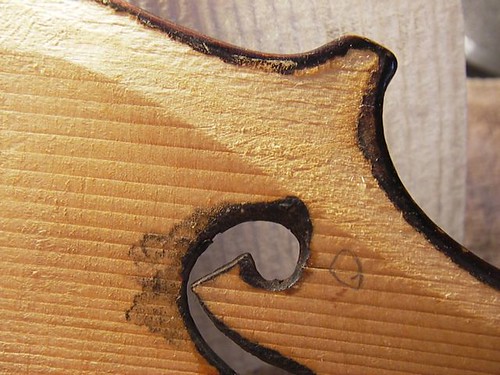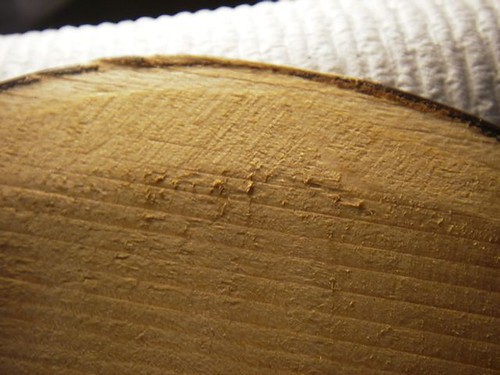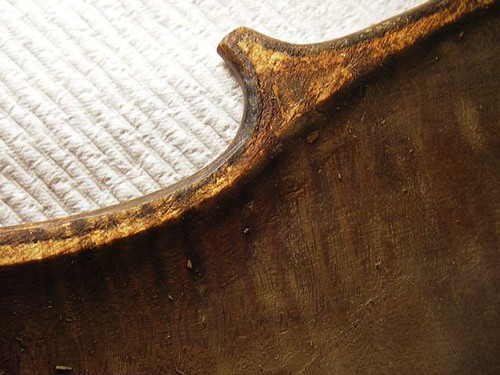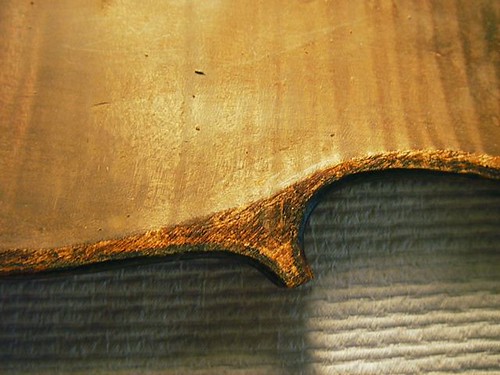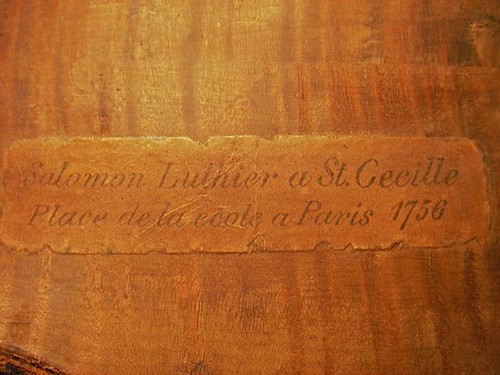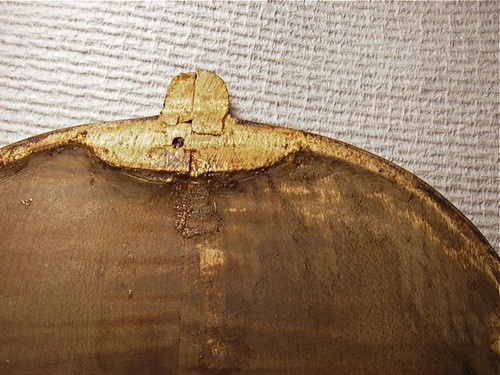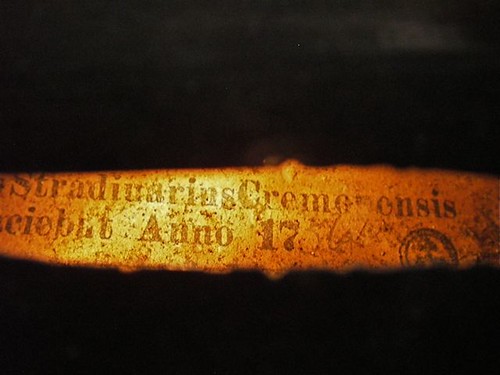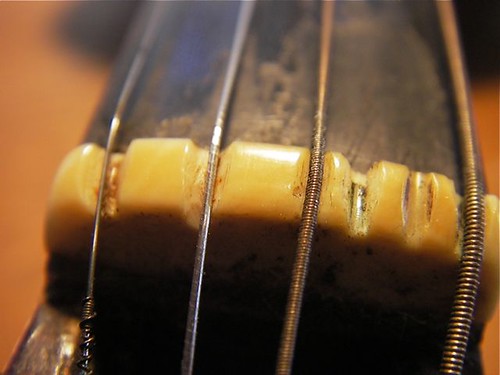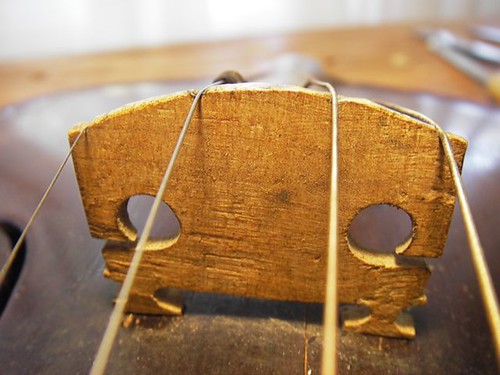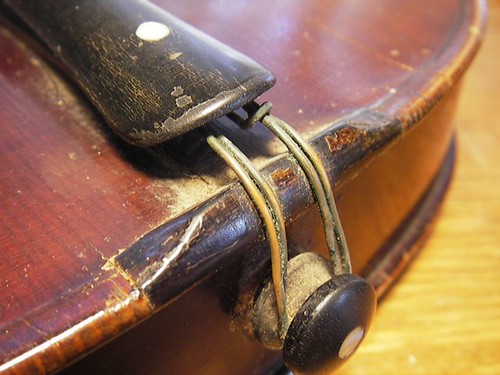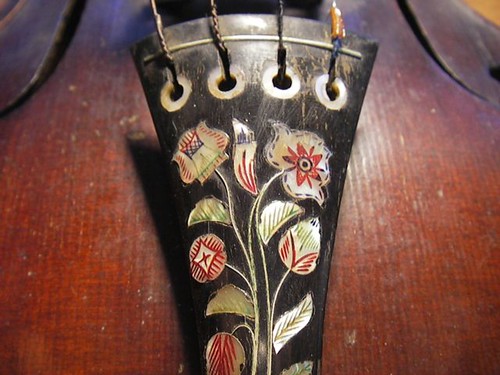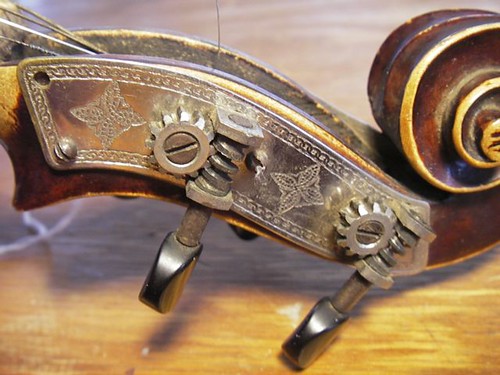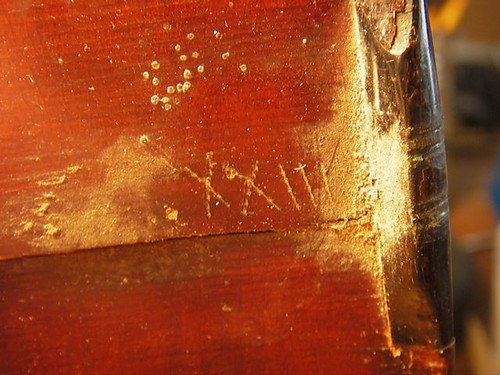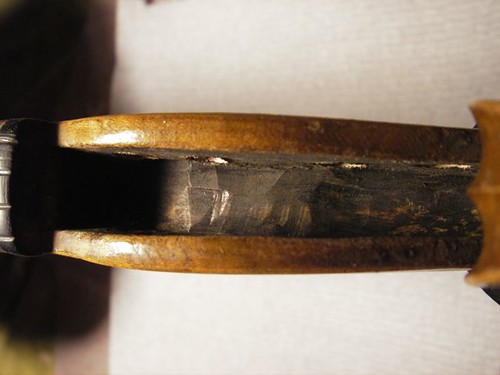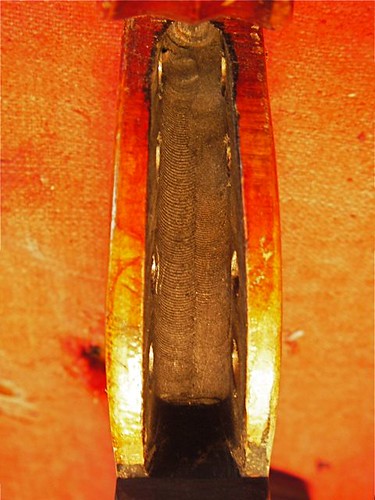Showing posts with label Student instruments. Show all posts
Showing posts with label Student instruments. Show all posts
Friday, October 25, 2013
Soundposts and craftsmanship
Cheap fiddles have been sold as long as fiddles have been sold. The customers are the poor or uneducated. It looks like a violin. I want to see if I like it before I spend much. The usual story we've all repeated when trying to save some money on something.
One came into the shop the other day. "Doesn't sound so good," was the complaint. Actually, "sounds really bad" was the complaint. The e-string was unbearable. Starting off with bad equipment is an easy way to answer the question "will I like it?", but that's part of the education angle.
Here's what the soundpost looked like.
This was how it was sold by a music store in the area -- a starter fiddle -- and at least implied that it was a product ready-to-go. It was not. Note the minor contact of the soundpost with the back. Not only will this prove less than optimal in tone, it is also dangerous for the instrument. Over time, this can create a crack in the back. Once a back-crack occurs on an instrument like this, it's all over. Out it goes with last week's garbage.
This factory-installed soundpost had badly cut bevels -- I actually doubt much thought was given to them at all -- and the post overall was too short.
We put a new one in.
We replaced the strings as well, the factory strings being only decorative. I probably shouldn't use the word 'decorative' that way.
It sounds much better now. Never going to be great, but at least it is essentially firing on all cylinders The owner might actually grow to like playing the fiddle.
Labels:
back,
repairs,
soundpost,
Student instruments,
violin repair
Saturday, March 3, 2012
Internal edgework and tool marks
A couple fiddles on the bench right now, that I'm trying to fix up, and not 100% sure that it will come out on either, but they had such different internal work that I thought that was interesting. This first one has a very wide platform inside the plate -- so wide that the sanding marks are still easily seen. Before this top was graduated (the inside scooped out) it was, perhaps, held down on a large belt sander to make a flat surface. You can see it here first as a difference in color from the lighter, rougher flat surface to the more defined cut surface towards the f-hole. Note also the stain which has filtered, or slopped, in through the f-hole, and the yet-to-be-repaired wing crack, located by the penciled circle.
Here's another shot of the wide sanded platform left around the edge. A little closer in, you might be able to better make out the parallel sanding marks.
By contrast, this one has almost no platform. The arching dives sharply away from the edge, making a dark shadow. In some places, a previous repairman noted that the ribs overhung too far inside. To 'fix' this, he shoved some woodputty to fill the gap. This back is also darkly stained and has about a pound of dried hide glue, in gobs all over, which I am slowly removing.
Another shot of the very thin edge. If you think of the external overhang, which you can see the stain of on the corner, then go back in 1 mm for the rib, and say, another 1.5-2 mm for the lining, you can see there's not much wiggle room.
The thin-platform fiddle has, on the other hand, a very interesting fake label!
Inside of the "Salomon" violin, as it was when I removed the back (not hard to do, as it was simply hanging on at a few places. The bass-bar appears to be a recent replacement, reasonably done, a new soundpost, and a dust-ball, which is usually a sign that it's been intact and played for a while. Note also the brown staining to the wood, especially visible on the ribs and end-block. Also not the glue spread everywhere on the top, with much excess at the rib-top joint.
Here's the upper-inside back of the "Salomon" violin. You can notice that the wood that was under the neck block and ribs is relatively white, while the rest of it dark. Also note the area from, say, 1 o'clock to 2 o'clock, where I have removed some excess hide glue. The water I used removed some of the 'age'. This is the same water I use to make my coffee, so maybe it will help keep me younger, too! The stain was added to the inside of this fiddle, along with the label, to deceive people. That's it, pure and simple.
Sunday, February 19, 2012
1756 Stradiuarius!

This is one of three fiddles I bought Friday, three of 10 the fellow brought in. It is not a great fiddle, not in great shape, but maybe will turn into something playable. If I can get two of them to work out, I might come out on it.
The seller had done enough research to know that Antonio was dead for nearly 20 years by 1756, so suspected that this may have been built by one of his sons. Of course, it wasn't -- being a factory fiddle ca. 1900.
Note the numerous nut grooves, as well as the guitar strings for the G and D -- no sense wasting a good used guitar string! Obviously this nut will have to be replaced, and we might be able to get the e-string groove to fit a little better. :-)
Homemade bridge with generous string spacing.
Copper wire tail-loop holding...
... an ornate tailpiece.
Mechanical tuners.
One often sees these Roman numerals on bows, to keep the stick and frog together. Less common on fiddles, though I have seen them under fingerboards. This one is hidden by the tailpiece when the instrument is strung up. Note the wire grooves in the saddle.
Thursday, January 19, 2012
Quickly hewed pegbox
In the shop today, I was setting-up a ca. 1900 factory fiddle, with the usual integral bass-bar and no corner blocks, for a customer. While fitting pegs, I noticed this one had quite a rough gouged bottom to its pegbox as well.
Here's a closer view, at slightly different lighting.
Thought it was an interesting comparison to a more recent factory fiddle with its milled pegbox. Quick work with a gouge vs. quick work with a milling machine.
The blog post on this milled pegbox is here.
Monday, October 31, 2011
Under the top of the 1989 fiddle

The results of repeatedly adjusting a soundpost that doesn't fit -- damage to the spruce top. I've removed the bass-bar, here on the right side of the photo. You can also see the pattern of the sander/router marks left when the plate was hollowed at the factory, as well as the staining around the edges of the f-hole during blacking. These instruments were fit with cleats at the factory at each wing, to help prevent cracking, on would assume.
The router or sander marks are part of a tradition in these low-end student instruments. Before the machines were cheap and manageable, folks used gouges, quickly.

Labels:
bass bar,
f-holes,
graduation,
repairs,
Student instruments,
violin repair
Saturday, October 22, 2011
Loose and thick, a 1989 German factory fiddle

This is a violin I got in trade, and it had a cracked end block (upper right). I pulled the top off to replace the block, and also to see what else I could find that needed help.
These late-20th-century German violins were built with great haste. The linings are continuous, running from end-block to neck-block, over the corner blocks, and not even touching the ribs in many places.

The bass bar was completely loose at the neck end, and appears to have never actually been in contact with the top.

At the other end, the bass bar does not contact the top either, except for a couple glue bridges.

Fortunately the top was stoutly made, so the instrument did not collapse. :-)
I'll take out the bass-bar, take a little thickness out of the top, and make a new bass-bar. It should sound better, though I don't know what it sounded like before (but I can guess!). At the very least I can sell it knowing that it will be in decent structural shape.

Labels:
blocks,
Linings,
repairs,
Student instruments,
violin repair
Tuesday, October 4, 2011
Shocked, shocked to find deceptive practices....

Looking over a fiddle, a bit beat-up, but with a back of nice wood, decent aged looking. You peek through the f-hole and see a very nice label. Pre-WWII, possibly German ("Hornsteiner"), possibly French ("copie"). Ooh la la -- very interesting.
Turns out, however, that that very interesting back and label are hiding a roughly hewed top, integral bass bar, fake lower blocks, no upper blocks. A cheap student instrument.

Well, anyway, we'll clean up this top, put in a real bass bar, and maybe have something of a fiddle -- but only after a decent amount of work.
Labels:
bass bar,
repairs,
Student instruments,
violin repair
Saturday, November 28, 2009
Student instruments
Student instruments are always problematic. They can suffer a great deal of abuse, unintentional and otherwise. Makers of student instruments -- factories almost always -- in the best of situations have to make something quick, strong, and reasonable. In other cases, they produce outright junk, which can neither be played nor repaired. If you are buying a new violin for $100, for example, you are buying junk.
Parents want their kids to succeed, and they want to save money. When it comes to material goods, however, the parents often think of the cost alone. A child learning to play a musical instrument can be handicapped by an unplayable instrument. That is no value, just cost, even if it is minimal. Learning, however, is the important thing -- that is the value. Any thought of resale value, particularly in a student instrument, pales in comparison to how the child's brain can be developed.
Here is a fractional cello that came into the shop recently. The top had cracked near the tailpiece. I could recognize it as the result of the endblock shrinking -- a very common event on low-end instruments. Preventable with good quality control, but right now that is not important to these makers. They sell instruments easily, so why change?
This one retails for about $1200, not a small amount of money for most parents in this area. And it is not the 'bottom of the barrel' -- I can actually get the top off in a reasonable amount of time with a minimum of damage.
For comparison, though, I thought it might be interesting to show some of the inside details, that don't show up when looking at the shiny new instrument.
Here's the lower corner block on the bass side --

Notice how the block has been roughly split out, and that the c-bout linings, rather than running inside the block, actually stop far short of it. If the glue fails here, these will spring loose, creating quite a buzz.
To show that it's not a fluke, here's the lower treble-side corner block.

It has similar problems. Again, to be fair, these are made very quickly. Any extra time is spent on the outside, the part seen by the customer.
The endblock was just as rough. In this photo, you can see one split-out side, where the drill had been quickly pushed through, probably after the top was glued on. It had a similar fragment, hanging by a thin fiber, on the other side, which I had removed prior to this photo.

Note that the block is loose from the ribs. It is harder to see that the ribs themselves are split, radiating out from the end-pin hole. You can see a linen cleat that I have installed on one of the cracks. This type of damage happens when the cello is dropped on its endpin. A better block, however, might have held.
Parents want their kids to succeed, and they want to save money. When it comes to material goods, however, the parents often think of the cost alone. A child learning to play a musical instrument can be handicapped by an unplayable instrument. That is no value, just cost, even if it is minimal. Learning, however, is the important thing -- that is the value. Any thought of resale value, particularly in a student instrument, pales in comparison to how the child's brain can be developed.
Here is a fractional cello that came into the shop recently. The top had cracked near the tailpiece. I could recognize it as the result of the endblock shrinking -- a very common event on low-end instruments. Preventable with good quality control, but right now that is not important to these makers. They sell instruments easily, so why change?
This one retails for about $1200, not a small amount of money for most parents in this area. And it is not the 'bottom of the barrel' -- I can actually get the top off in a reasonable amount of time with a minimum of damage.
For comparison, though, I thought it might be interesting to show some of the inside details, that don't show up when looking at the shiny new instrument.
Here's the lower corner block on the bass side --

Notice how the block has been roughly split out, and that the c-bout linings, rather than running inside the block, actually stop far short of it. If the glue fails here, these will spring loose, creating quite a buzz.
To show that it's not a fluke, here's the lower treble-side corner block.

It has similar problems. Again, to be fair, these are made very quickly. Any extra time is spent on the outside, the part seen by the customer.
The endblock was just as rough. In this photo, you can see one split-out side, where the drill had been quickly pushed through, probably after the top was glued on. It had a similar fragment, hanging by a thin fiber, on the other side, which I had removed prior to this photo.

Note that the block is loose from the ribs. It is harder to see that the ribs themselves are split, radiating out from the end-pin hole. You can see a linen cleat that I have installed on one of the cracks. This type of damage happens when the cello is dropped on its endpin. A better block, however, might have held.
Subscribe to:
Posts (Atom)



